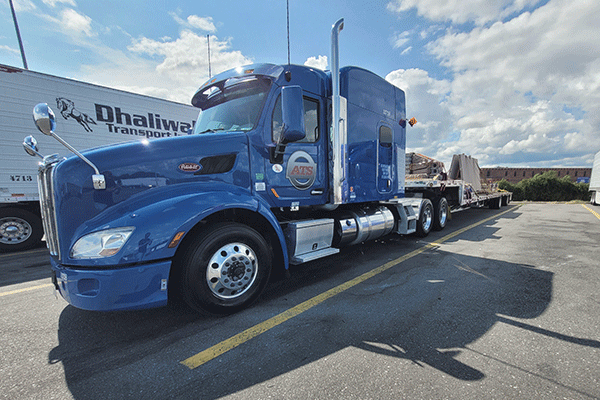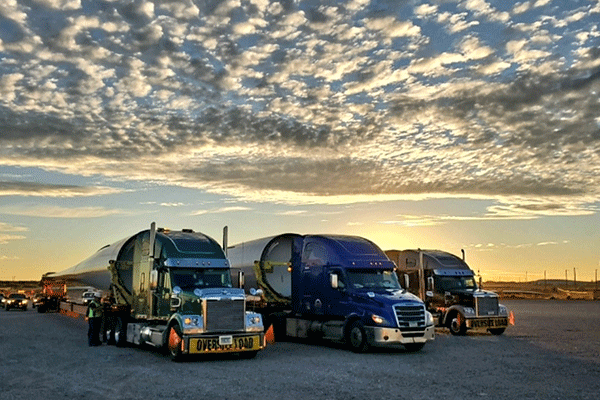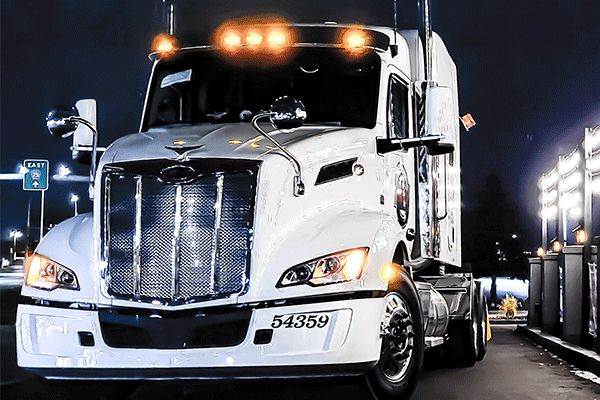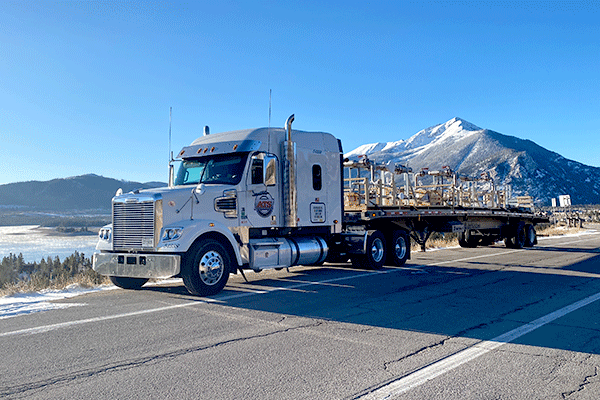
As we near the conclusion of 2021, and begin the twenty-second leg of our 2000’s journey — with a year that promises more challenges, triumphs and learning opportunities — a bit of reflection would do all of us well.
The transportation industry, for what it’s worth, functioned in the same ways this year as it did in years prior; as a central conduit for American business and International trade, keeping supply chains moving and many businesses in good health.
That said, 2021 also brought unique challenges and some notable instability to this industry’s shores — instability that probably left you feeling frustrated at times and elated at others.
Here at Anderson Trucking Service (ATS), 2021 was our 66th year in the transportation business. During this time, we’ve hurdled our share of challenges and navigated a fair bit of instability, but all of that experience didn’t make 2021 any less demanding.
You see, this year presented a list of challenges — some anticipated and some not — that made life more difficult on many industry stakeholders — regardless of how prepared they were.
As you know, being an educated consumer and optimizing for the future takes reflection and the ability to learn from the past. This article will help you do just that.
Although there is plenty to be said about the state of the transportation world following an eventful 2021, below you’ll find an overview of:
- Four primary indicators used to gauge the overall health of the transportation industry.
- How these indicators shifted throughout 2021.
- What you should expect 2022 to look like.
At its conclusion, this article will leave you with a far better understanding of how and why transportation changed this year, what influenced those shifts and what shippers, like you, should keep in mind as the ball drops on 2022.
What Metrics Indicate The Transportation Industry’s Overall Health?
Transportation is an intricate industry. From flatbed overhang allowance — which varies by state — to the sheer number of provider and equipment types available, shippers looking for a timely and budget-friendly transportation solution certainly have a lot to keep in mind.
Over the years, this industry has done an apt job of meeting the needs of small, mid, and large-sized businesses by providing a truck and trailer where needed.
In 2021, though, this industry saw a shift.

When analyzing the health of national transportation supply chains, there are four key indicators used to do so. These are:
1. Demand of Freight-
- How has the demand for trucking services shifted?
- Has demand risen, lowered or stayed the same, based on the way money is being spent over a given period of time?
-
-
- How has the supply of available trucking-related services shifted?
- Has the supply of these services risen, lowered or stayed the same?
- Do current supply levels adequately meet those of demand?
-
-
- Has the cost of providing trucking services changed?
- Have these expenses — expenses like fuel, truck maintenance and insurance costs — risen or lowered?
-
- Have spot and contract prices shifted substantially?
- How stable have these prices been over the last time period?
- Are these shifts likely to continue?
In a healthy transportation market, the supply of trucking services adequately meets market demand and the cost of providing them undergoes little volatility.
When this is the case, businesses with cargo to move have an easier time maximizing their transportation dollars and fulfilling customer commitments.
That said when the interplay between supply and demand adjusts negatively — with demand outpacing supply — and the costs associated with providing transportation capacities rise, then the price of trucking services responds — at the detriment of many supply chains.
In 2020, when Coronavirus breached the United States’ coasts, halting many of America’s core industrial activities, this is exactly what happened. This change, and the continued effect of Coronavirus, reverberated well into 2021.
Let’s continue by talking about how each of the four core transportation-industry health indicators bore this impact.
How Was Transportation Industry Demand Impacted During 2021?
Most notably, 2021 marked a continued change in the way that citizens around the world spent their money.
Before COVID, individuals and households spent a good portion of their earned income on experiences; vacations, concerts, sporting events, services and other non-tangible commodities.
Beginning in 2020, though, access to these spending avenues closed entirely — leaving consumers with fewer options for utilizing their hard-earned dollars.
While some people saved this surplus, stockpiling funds for a rainy day or retirement, others didn’t. Opting instead to spend their income in other ways.
As a result, purchases of physical items — products manufactured and distributed with help from the transportation industry — have increased substantially over the past two years.
The incessant demand of international consumerism — spurred further by COVID’s presence — directly influenced the trucking industry we knew this year.
How Was Transportation Industry Supply Influenced During 2021?
Starting at the onset of the pandemic — in early spring, 2020 — two essential pieces of the truck driver recruiting pipeline were put on standby, operating at limited capacities.
These were:
- Truck driver training schools — responsible for teaching truck drivers how to perform the essential functions of their duties, including, how to maneuver a loaded trailer, common safety practices for highway driving, how to prepare for extended hauls, etc.
- The FMCSA’s drug and alcohol clearinghouse — charged with maintaining safe roadways by policing the drug and alcohol use of commercial motor vehicle operators. The drug and alcohol clearinghouse is responsible for evaluating and treating truck drivers with past violations before allowing them back onto public roadways.
The “production” delay and closure of these institutions blanketed the United States for a large portion of 2020. And, although many of them have opened once more, the disturbance to the flow of drivers into this industry is still felt today.
For this reason, 2021 forced many trucking companies to operate with a shortage of quality drivers — the most important piece of their business model. In turn, the shippers and consumers with cargo to move were able to access far less supply to meet their demand.
As such, if 2021 made it more difficult to find a truck at the price points you’re accustomed to, rest assured, you’re not alone.

How Did The Cost of Providing Transportation Services Change in 2021?
For a portion of the year, the costs of operating a pool of trucks and employing their drivers were mixed with some highs here and lows there.
In the transportation industry, four of the largest expenses paid by every company, regardless of size, are paying truck drivers, purchasing fuel, maintaining equipment and holding insurance.
These four expenses can also be some of the most volatile — particularly in a congested marketplace.
Throughout 2021 — and especially in its latter half — these four expenses experienced a material shift, driving the cost of providing transportation services skyward.
Most specifically, this year’s 365 days influenced truck driver salaries, fuel prices, equipment maintenance and insurance premiums to change in the following ways:
How Did Truck Driver Salaries Change in 2021?
The compensation given to truck drivers grew exponentially over the course of 2021 for two major reasons.
Firstly, demand-rich markets shift the bargaining power into the hands of truckers. This change happens at the detriment of both shippers (who pay heightened spot rates) and the trucking companies that employ them.
You see, in recognition of the increased value they hold, many truckers look to separate themselves from the employ of mid-large-sized trucking companies.
Opting instead to try their hand as independent contractors where they can fully optimize their earning potential. As a result, to avoid a mass exodus, many trucking companies were forced to increase the salary they pay their most important assets.
Competition from external job markets is the second reason truckers got a pay bump in 2021. As a whole, truck drivers possess a highly employable skillset that, due to the previously mentioned shutdowns, was relatively hard to procure this year.
As such, other industries like construction — which offer workers competitive salary packages coupled with the opportunity to sleep at home each night — fought for the attention of many CDL drivers and increased the dollars trucking companies paid to retain their services.
How Did The Cost of Fuel Change in 2021?
Diesel fuel prices were relatively stable for the first nine, or so, months of 2021. More recently, however, the cost of filling a semi-truck’s tank has increased substantially with a gallon of fuel costing as much as $3.73 on average (up 41.4% compared to beginning-of-the-year price points).
How Did The Cost Of Equipment Maintenance and Renewal Change in 2021?
Slowly, over the course of this year, the cost of maintaining and replacing semi-tractors has increased around our nation. This price uptick, which can be attributed to an ongoing shortage of labor and parts as manufacturers struggle to keep up, is only growing as we approach 2022.
How Did Insurance Costs Change in 2021?
Auto physical damage, auto liability, cargo and general liability insurance costs rose in 2021 just as they did in previous years. Most notably, however, 2021 saw insurance premiums increase due to the hardening of insurance markets as a result of the increased frequency and materiality of nuclear verdicts.
How Did The Cost of Procuring Transportation Services Change in 2021?
Together, supply, demand and the costs incurred by the transportation industry dictate the price of doing business within it.
And, in a year where supply dwindled, demand surged and costs increased, it’s no wonder why freight rates occupied unprecedented price points. This probably isn’t a surprise to you, though.
As transportation companies saw their cost of services steadily increase throughout 2021, these added expenses trickled down to your income statement as well. Spot rates increased and previously-contracted prices lost progressively buying power.
Some of these price hikes can also be tied to the migration of truckers leaving their companies which, in turn, made it more difficult for carriers to competitively price their services and lead to more competition on brokerage load boards.
And, even with a network of great providers in your corner and a good amount of planning ahead, the rates you paid in the past were unreachable this year.

What Will 2022 Hold For The Trucking World?
If all of this information makes you wonder, “how long will the transportation industry face these challenges?” and “what can I do to make the most of my transportation supply chain in 2022?” you’re in the right place.
Sure, the demand for trucking services may outpace their supply for the foreseeable future and the current state of congestion is enough to leave you feeling uneasy, but there is hope on the horizon.
Read our 2022 Transportation-Industry forecast article for an in-depth analysis of what to expect in the coming year and, most importantly, what you can do to plan.
Finally, if you have any questions about how ATS can help you meet your deadlines and navigate the trucking industry going forward, reach out to us today. We’re happy to assist you in any way you need.




